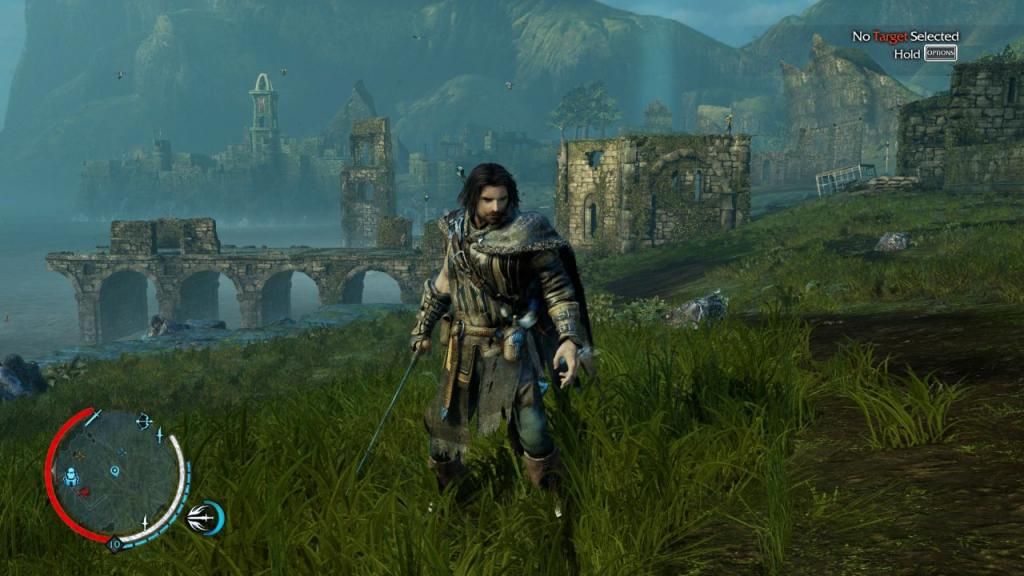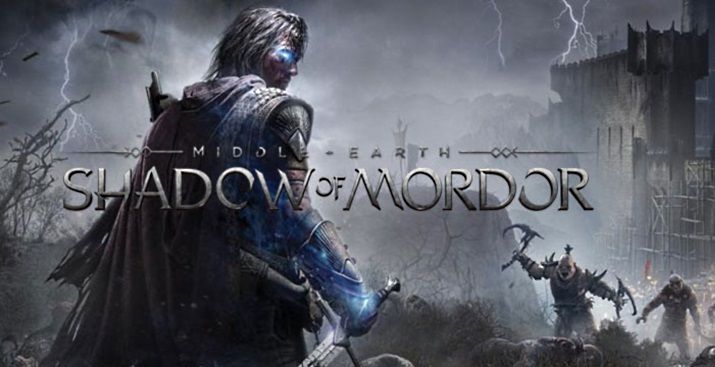- Format: PS4 (version reviewed), PS3, PC, 360, Xbone
- Unleashed: Out Now (PS4, PC, Xbone), November 21st (PS3, 360)
- Publisher: Warner Bros. Interactive
- Developer: Monolith
- Players: 1
- Site: https://www.shadowofmordor.com/agegate/
All signs point to Shadow of Mordor being a cheap and lazy product. The YouTube review campaign turned out to be in the grip of extremely shady PR practices. The game itself steals shamelessly and at great volume from other, big-name titles. How, then, has it turned out to be one of the best games of the year?
SoM may well be set in Middle Earth, but our protagonist’s story is at its core the overused videogame cliché of ‘loved ones killed, kill hundreds of living things back to make things okay’. Stepping into the battle-worn boots of the ranger Talion some time between the events of The Hobbit and The Fellowship of the Ring, you die almost as soon as the game starts; but as a bonus, you become bound to a wraith which affords you some cool powers. Swings and roundabouts, eh?
The number one danger when creating an original tale in Middle Earth is clashing with canon. Tolkien was almost obsessive in the construction and detail of his universe, and as such, examine this story with a magnifying glass and cracks and holes show up all over the place. The overarching plot here is, in truth, pretty simple; but the dialogue is good, and the acting is very good.
Y’know that stealing from other games we mentioned? Well, try to imagine Assassin’s Creed of the Rings, and you’re halfway there. Mordor may be neither as barren nor as mountainous as Tolkien described here, but there’s still plenty for Talion to clamber up, hide behind, and leap from. There are also stealth instakills, collectibles dotted across the world, and even towers that you must scuttle up in order to fill in sections of the world map.

Although you can sneak around, hide on the rooftops and kill undetected, you’ll spend huge chunks of time in open combat. Your very first battle will make the… ah… influence of the Batman: Arkham games immediately obvious, the combat system from which has effectively been dropped in here wholesale. Even the unlockable combat abilities mimic Batman’s exactly, for the most part. We’re happy to report however that we’d say fights here are – dare we say it? – just a little faster and smoother than Batman’s. There’s a sprinkle of Far Cry 3 here too, with a bow and wild & caged tigers (sorry, Caragors) that you can release to wreak havoc on your enemies. Far Cry never had gigantic Graugs towering over your character, though…
That’s not quite the end of SoM’s pilfering. Batman’s ‘detective mode’ is also here under the guise of entering the wraith world, which at least means that the ability makes more sense here in context. As well as being able to see enemies through solid objects, you’ll also be able to easily see nearby collectibles and health-restoring herbs. This ability also allows you to see details of any nearby high-ranking enemies; and this is where SoM revels in its own ideas.
The enemies you fight are not Humans or Orcs but Uruks, a sort of cross between the former two races. This allows them to have more of a personality, which Monolith capitalises on. There is a single Uruk army stretched across Mordor with its own hierarchy. Five warchiefs sit at the top, a few levels below Sauron. Below them are Captains, and below them more Uruks poised to fight for promotion. Each one has a unique name, appearance, and set of strengths and weaknesses; randomly generated we would presume. If one of these named Uruks stumbles across you in your travels (or if you actively hunt them down) they will taunt you as introduction – perhaps referring to your last meeting, or how or where they found you – and then the fight begins.
There are constant power struggles within the army, even without your interference. Captains will be challenged and replaced by lower ranking Uruks, and Captains will fight amongst themselves for a vacant Warchief slot. These battles and feasts appear as side missions on your map, ready for you to gatecrash. Depending on who you kill – or even if you are killed yourself – you affect the outcome. In fact, your undeath means that when you fall in battle, you simply respawn at the nearest tower. However, whichever Uruk killed you increases in power, and stands a good chance of promotion. Later in the game you unlock the ability to ‘dominate’ Uruks, turning them to your side – which opens up new opportunities. Uruks under your command can progress through the ranks just like any other. You could even fight and dominate a Warchief’s bodyguards one by one, giving him a surprise when you finally challenge him. Giving enemies personalities in this way generates specific revenge targets, in a way that is usually only seen in online games. You can even avenge the deaths of people on your friends list (er, within the game).

“Me vote UKIP! Me keep Mordor for Uruks! Bad humans go home!”
All standard Uruks, and even some high-ranking ones, can be killed instantly from stealth; a system that it’s possible, and extremely tempting, to exploit. Stay high and Uruks seem almost blind, even if you’re directly in their line of sight from mid-distance. Much more cheesetastic, however, is the fact that you can stealth-kill from directly in front of your target if you run up to them quick enough, and trigger the kill before the AI finishes its unaware-suspicious-aware cycle (which isn’t difficult).
Most importantly though, SoM does the open-world thing right. There’s only a minimum of linear play before you’re allowed to run off and explore, and side missions and optional activities melt into the experience in a way most other games can only dream of. Finding and activating the towers is easy, and reveals everything of interest on the map; no frustrating wandering here. The Uruk army persists even after the story is done with, meaning there’s always something to come back for. And you will come back to this game – again and again.










Comments